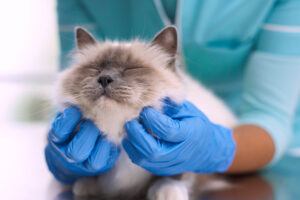As pet parents, our furry companions bring immense joy into our lives, but their adventurous spirit and playful nature can sometimes lead to unexpected situations. While we always hope to avoid emergencies, having some basic pet safety knowledge is important to ensure their ongoing well-being.
Stay Calm and Assess the Situation
In any emergency, maintaining composure is extremely important. Your pet will pick up on any anxiety that you’re feeling, so where possible try to keep this in check. Always assess the severity of the situation first, to determine if and how urgently veterinary attention is needed.
Download our practical symptoms checklist from the 2024 Pet Health Monitor to help you distinguish between early warning signs that may not require an urgent vet visit and true veterinary emergencies. This handy table can be printed and stuck to the fridge door for easy access and referral.
Recognising Choking Symptoms
If your pet is choking, they may show any of the following individual or combination of symptoms:
- Sudden distress
- Pawing at the mouth
- Excess saliva (drooling)
- Coughing, gagging, or retching
- Rubbing their face against the ground
- Bluish skin or mucus membranes (the gums, lips, nostrils, around the eyes), due to lack of oxygen
What to Do If Your Pet Is Choking
There is a high risk of being bitten if attempting to remove an object from a pet’s mouth or the back of their throat, as the animal will be distressed and fearful. If your pet is not in immediate distress, take them urgently to your nearest vet.
- Remove the Object if Possible: If the situation requires immediate attention and you can see the object within/at the back of your pet’s mouth, ask for help from a family member or bystander to try to keep your pet still and hold their jaws safely open, while you attempt to remove the object
- If You Cannot See the Object: Do not put your fingers in their mouth / down their throat, as you may cause further choking or injury. Take your pet immediately to your nearest vet.
- Do Not Poke or Push any Visible Object Further down the Throat: This could worsen the blockage.
- If There Is String or a Similar Item Visible Externally Around Their Neck: Carefully remove it to prevent further choking. If there is a visible wound once the item has been removed, make an appointment to see your local vet.
Controlling Bleeding and Handling Fractures with Care
Bleeding
- Keep yourself and your pet calm. Approach them quietly and gently.
- Clean your hands if possible and identify where the blood is coming from on the body. Be careful as they may be frightened and in pain, which may cause them to bite or scratch.
- Use a clean towel or bandage to apply firm pressure to the wound.
- Always seek veterinary advice, by phone or through telehealth, especially if the bleeding does not stop or your pet remains distressed.
Fractures
- Immobilise the area: If possible, stop the pet from moving the affected area and seek veterinary care immediately.
Dehydration
Signs of dehydration can range from a loss of appetite, dry nose, panting and reduced energy to vomiting, sunken eyes, dry sticky gums, skin tenting and thick saliva. For early signs of dehydration, temporarily reduce/stop exercise, and play, offer water by giving your pet small amounts frequently in a bowl, cupped in your hands or by syringe into the mouth. You can also offer ice pieces or add water to their food. For more advanced signs of dehydration, seek urgent veterinary advice.
Heat Exposure and Heatstroke
Signs of heatstroke include excessive panting and drooling, agitation, weakness, confusion, increased heart rate, vomiting, diarrhea, and uncoordinated movements. If possible, move your pet to a cool place or provide shade, use a moist towel or fan to cool them, provide fresh water, and seek veterinary care immediately.
Pets suffering from heat stroke can be at risk of hypothermia from rapid drop in body temperature if aggressive cooling is applied. Never immerse your pet in a cold bath or ice and be careful with applying wet towels.
Recognising Ingestion of Toxins and Foreign Bodies
Pets, especially dogs, are notorious for eating things they shouldn’t. From chocolate to grapes and raisins, multiple items can be toxic or harmful if ingested.
Explore our 2024 Pet Health Monitor to learn more about common toxins and foreign bodies that your dog or cat may unsuspectingly decide to nibble on.
Poisoning
Poisoning from toxins or foreign bodies requires urgent veterinary care. Do not attempt to induce vomiting at home, as this can make the situation worse. Instead, make a written or mental note of when and how much of the substance was ingested and if possible, bring any packaging to the vet.
If you suspect your pet has ingested a toxin, contact the Animal Poisons Helpline for information and/or emergency instructions.
Bites and Stings
Curious pets are usually bitten around the head, neck and front legs. For venomous snakes or spider bites, first try to keep your pet still and minimise any movement to prevent venom from spreading. If possible, apply a pressure bandage over and around the bite site, but do not use a tourniquet or restrict blood flow. Also avoid trying to find the bite site or cleaning it, as this wastes valuable time. Pick up and carry your pet if possible and immediately transport them to your nearest vet.
Insect bites and stings are rarely fatal, but some pets can have severe allergic reactions. If you notice that your pet has been bitten by an insect or if it suddenly experiences difficulty breathing, severe swelling, vomiting, diarrhea or collapse, seek urgent veterinary treatment.
Accidents and Traumatic Injuries
For road traffic accidents, ensure your own safety first. Stop traffic if possible and if necessary. Check for bleeding and breathing and start CPR if necessary. Carefully move your pet off the road. Apply pressure to stop heavy bleeding and seek immediate veterinary care, even if there is no visible damage, as internal injuries may not always be obvious.
Seizures
Seizures can be a frightening experience for both you and your pet. They can last anywhere from seconds to minutes and may result in loss of consciousness, bladder, bowel and voice control. During a seizure, keep your pet safe and clear the area around them. After the seizure, try to reassure them, keep calm, and ensure they remain safe from injury. Note the seizure duration and symptoms and contact your vet for advice and further diagnostic work-up.
Seek Professional Veterinary Care
While first aid is essential, it is not a substitute for professional veterinary care. Always seek veterinary advice or in-person attention for any injuries or illnesses that cause concern and always in an emergency.
By familiarising yourself with these first aid tips and being prepared for emergencies, you can become a proactive and confident pet parent capable of handling unexpected situations effectively. Always remain calm, prioritise your pet’s safety and wellbeing, and don’t hesitate to seek veterinary help when needed. Your quick actions and preparedness can significantly impact your pet’s health and recovery.
Sources
Animal Welfare League n.d., Your guide to pet first aid.
Lee, D.D. ed., (n.d.). First aid tips every pet owner should know. [online] Best for Pet. Available at: https://bestforpet.com.au/pet-advice/first-aid-tips/#:~:text=Stay%20calm%20and%20assess%20the%20situation%201%20Control,bites%20…%208%20Manage%20seizures%20…%20More%20items.
PetSure Pet Health Monitor 2024 2024, petsure.com.au, 1 May, PetSure, petsure.com.au, p. 62, viewed 29 May 2024, <petsure.com.au/pet-health-monitor>.
https://www.greencrossvets.com.au/pet-library/articles-of-interest
Pet insurance can help by covering a portion of the eligible vet bill if the unexpected happens. Because it is difficult to predict the costs of veterinary care, it can help to have measures in place to help prepare for the unexpected. Check out our partner network and explore our policy tools to find a pet insurance policy.
Not all conditions or items are covered by Pet Insurance. Refer to the applicable Product Disclosure Statement for information about coverage and exclusions.



 Fact checked
Fact checked





